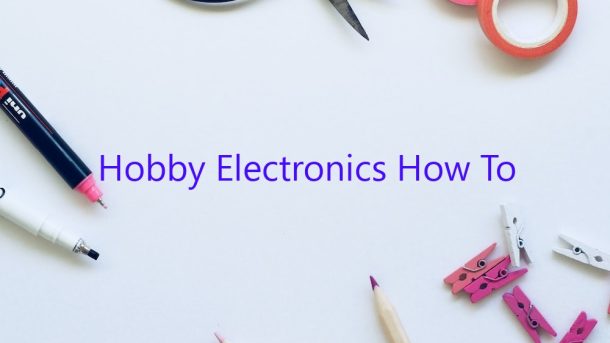Hobby Electronics How To
There’s a lot to know about hobby electronics, and it can be daunting to figure out where to start. In this article, we’ll walk you through the basics of hobby electronics, from soldering to programming.
First, let’s start with some basics. Hobby electronics is a term used to describe a wide range of activities, from making simple circuits to programming microcontrollers. Generally, hobby electronics projects fall into one of two categories: circuits and microcontrollers.
Circuits are the simplest type of electronics project. They involve connecting a few components together to create a functioning circuit. Microcontrollers are a bit more complex, and involve programming a small computer to control a circuit.
Both circuits and microcontrollers can be used to do a wide range of things, from controlling LEDs to monitoring environmental data. However, before you can start building projects, you need to learn a few basic skills.
The first skill you need is soldering. Soldering is the process of attaching a piece of metal to another piece of metal by melting a small amount of metal and flowing it onto the joint. Soldering is used to create electrical connections between components, and it’s an essential skill for hobby electronics.
The next skill you need is programming. Programming is the process of telling a computer what to do. In the context of hobby electronics, programming is used to control microcontrollers.
Once you’ve learned the basics, you’re ready to start building projects. The best way to learn is by example, so we’ve put together a few beginner projects to get you started.
Beginner Circuit Projects
One of the simplest types of electronics project is a circuit. A circuit is a collection of electronic components that are connected together to create a functioning circuit.
In this section, we’ll show you how to create a few simple circuits. We’ll start with the most basic circuit and work our way up to more complicated circuits.
The first circuit we’ll build is a simple LED circuit. An LED is a light-emitting diode, and is a common component in electronics projects.
To build the LED circuit, you’ll need the following components:
1 LED
1 resistor
The resistor is used to limit the amount of current flowing through the LED. If you don’t use a resistor, the LED will burn out.
To build the circuit, connect the LED to the resistor, and then connect the resistor to the positive terminal of the battery.
Here’s a diagram of the circuit:
The next circuit we’ll build is a basic switch circuit. A switch is a device that can be used to turn on and off electrical circuits.
To build the switch circuit, you’ll need the following components:
1 switch
1 resistor
To build the circuit, connect the resistor to the switch, and then connect the switch to the positive terminal of the battery.
Here’s a diagram of the circuit:
Beginner Microcontroller Projects
Now that you’ve learned the basics of circuits, it’s time to learn about microcontrollers. Microcontrollers are small computers that can be used to control circuits.
In this section, we’ll show you how to program a microcontroller to control a simple LED circuit. We’ll be using the Arduino programming language for this project.
The Arduino is a popular microcontroller, and it has a wide range of features that make it perfect for hobby electronics projects.
To program the Arduino, you’ll need the following components:
1 Arduino
1 LED
1
Contents
Can you learn electronics as a hobby?
Yes, you can learn electronics as a hobby. In fact, it’s a great way to learn about how electronic devices work and to tinker with them to see what you can do.
There are a variety of ways that you can learn about electronics as a hobby. You can find a lot of information online, in books, and even in classes. There are also a number of electronic kits that you can purchase that will help you get started.
One of the best things about learning electronics as a hobby is that you can start off small and work your way up. You don’t need to have a lot of experience or knowledge to get started. You can learn as you go, and you can always refer to resources online or in books when you need help.
One thing to keep in mind when learning electronics as a hobby is that it can be a bit of a challenge. It takes time and practice to become good at it. But if you’re willing to put in the effort, you can learn a lot and have a lot of fun in the process.
How do I start doing electronics?
Do you want to start doing electronics? It’s a great hobby that can lead to some really cool projects. Here’s how to get started.
First, you’ll need to get some supplies. You’ll need a soldering iron, some solder, wire cutters, pliers, and a voltmeter. You may also want some other tools, like a hot glue gun, a drill, or a saw.
Once you have your supplies, you’ll need to learn how to use them. There are a lot of great tutorials online, so be sure to do some research before you start.
Once you’re familiar with the tools and how to use them, you’ll need to start learning about electronics. There are a lot of great resources out there, like books, websites, and YouTube videos. Be sure to check out the tutorials on the Adafruit website. They have a lot of great tutorials for beginners.
Once you’ve learned about electronics, it’s time to start making some projects. There are a lot of great projects out there, so be sure to find one that interests you. You can find projects on websites like Make: Magazine and Instructables.
If you’re having trouble finding a project, or you’re not sure where to start, try making a simple LED circuit. It’s a great project for beginners, and it’s a lot of fun to see the LED light up.
Once you’ve made a few projects, you’ll start to get the hang of it. And before you know it, you’ll be making some really cool projects. So get started today and have some fun!
Is Arduino a good hobby?
Arduino is a microcontroller board with a development environment based on Processing. It is intended for artists, designers, hobbyists, and anyone interested in creating interactive objects or environments. Arduino can be used to control a variety of electronic devices, from simple LEDs to complex motors.
How can I learn electronic books?
If you’re looking for a way to read electronic books, you’re in luck. There are a number of ways to do so, and the best way for you may depend on your reading habits and preferences.
One way to read electronic books is to download them to your computer or device. This can be done straight from the publisher’s website, or you can use a service like Amazon’s Kindle store. Once you have the book downloaded, you can read it on your computer or device, or you can transfer it to a Kindle or other e-reader.
Another way to read electronic books is to subscribe to a service like Scribd or Oyster. These services allow you to read books online or on your device, and they have a large selection of books to choose from.
If you’d rather not download or subscribe to a service, you can also read electronic books online. Many publishers have websites where you can read books for free, and there are also a number of websites that offer free e-books.
Whichever way you choose to read electronic books, be sure to choose a format that is comfortable for you. If you like to read in bed, for example, you may want to download books to your device so you can read them offline. If you like to read on your commute, you may want to subscribe to a service that allows you to read books online.
Whatever your reading habits, there is a way to read electronic books that is perfect for you. So, get started today and start enjoying the convenience and flexibility of e-books!
Is electronics difficult to learn?
The answer to the question of whether or not electronics is difficult to learn is a resounding “no.” Electronics is not difficult to learn – in fact, it can be quite enjoyable and rewarding. However, as with any activity, there is a learning curve to overcome. With some patience and perseverance, anyone can learn the basics of electronics and start creating interesting and useful projects.
One of the best things about electronics is that there is no one correct way to learn it. Some people prefer to start by reading about the theory behind electronics, while others prefer to jump in and start building things. There are plenty of online resources and tutorials available to help get you started, no matter which approach you choose.
One of the most important things to remember when learning electronics is that it is a hands-on activity. You will not learn everything by reading about it – you need to get your hands dirty and start building things. This can be a bit daunting for beginners, but with a little practice it becomes easier and more fun.
The best way to learn electronics is to start simple and gradually build up your skills. There are plenty of beginner-friendly projects available online, so there is no need to try and tackle something too complex right away. With a bit of practice, you will be able to build more complicated projects and start experimenting with your own ideas.
So, is electronics difficult to learn? The answer is a resounding “no.” Anyone can learn the basics of electronics with a little practice and patience. It can be a fun and rewarding activity, and it can be used to create many interesting and useful projects.
What are the basics of electronics?
When most people think of the word “electronics,” they think of devices like televisions, radios and phones. However, the field of electronics is actually much broader than that. At its core, electronics is the study of how to control and use electricity to create and use technology.
There are a few basic concepts that are essential to understanding electronics. The first is voltage. Voltage is a measure of how much electricity is flowing through a circuit. It is measured in volts. The second is current. Current is the amount of electricity that flows through a circuit in a given amount of time. It is measured in amperes, or amps. The third is resistance. Resistance is a measure of how much a circuit resists the flow of electricity. It is measured in ohms.
These three concepts are essential to understanding how electronics work. In order to create a working circuit, you need a source of voltage, a conductor to carry the current and some resistance to limit the current. Most electronic devices use a combination of these three concepts to create electricity and function.
In order to create a working electronic device, you need to understand these three concepts. You also need to understand the basic components of an electronic circuit. The most common components are resistors, capacitors, inductors and transistors. These components are used to control the flow of electricity in a circuit.
Once you understand these basics, you can start creating your own simple electronic devices. There are a number of tutorials and online courses that can teach you the basics of electronics. There are also a number of kits that can help you get started.
How long does it take to learn Arduino?
Arduino is a popular open-source microcontroller platform used by hobbyists, artists, and developers for creating interactive objects or environments. Arduino can be used for a variety of purposes, from home automation to robotics.
How long it takes to learn Arduino depends on your level of experience and what you want to use Arduino for. If you’re completely new to Arduino, you’ll need to learn some basic concepts and terminology, and then you’ll be able to start building projects. If you’re already familiar with basic electronics, you’ll be able to start building projects more quickly.
There are a variety of tutorials and resources available online to help you learn Arduino. The Arduino website has a variety of tutorials, and there are also many other online resources, including video tutorials and online courses.
It typically takes around 10-15 hours to learn the basics of Arduino, but it will vary depending on your experience and knowledge. Once you have learned the basics, you can start building more complex projects.




